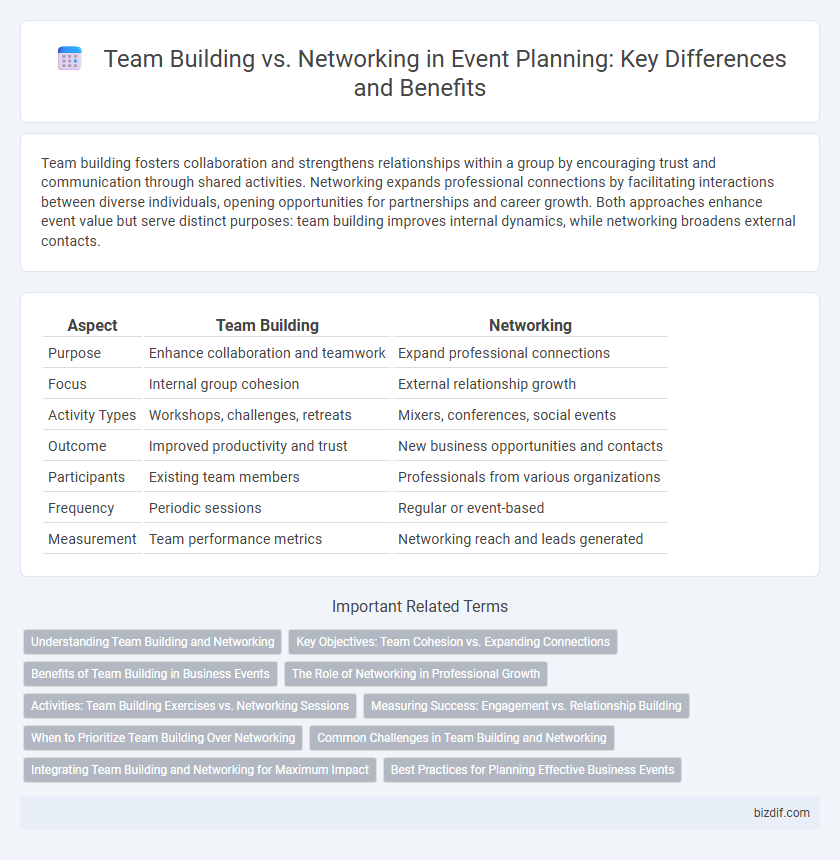Team building fosters collaboration and strengthens relationships within a group by encouraging trust and communication through shared activities. Networking expands professional connections by facilitating interactions between diverse individuals, opening opportunities for partnerships and career growth. Both approaches enhance event value but serve distinct purposes: team building improves internal dynamics, while networking broadens external contacts.
Table of Comparison
| Aspect | Team Building | Networking |
|---|---|---|
| Purpose | Enhance collaboration and teamwork | Expand professional connections |
| Focus | Internal group cohesion | External relationship growth |
| Activity Types | Workshops, challenges, retreats | Mixers, conferences, social events |
| Outcome | Improved productivity and trust | New business opportunities and contacts |
| Participants | Existing team members | Professionals from various organizations |
| Frequency | Periodic sessions | Regular or event-based |
| Measurement | Team performance metrics | Networking reach and leads generated |
Understanding Team Building and Networking
Team building focuses on enhancing collaboration, trust, and communication among team members to improve overall productivity and cohesion. Networking emphasizes creating new connections and expanding professional relationships beyond existing groups to foster opportunities for growth and knowledge sharing. Both strategies are essential in event planning to balance internal team dynamics with external relationship development.
Key Objectives: Team Cohesion vs. Expanding Connections
Team building events prioritize enhancing team cohesion by fostering trust, improving communication, and encouraging collaboration among members to achieve shared goals. Networking events focus on expanding professional connections, creating opportunities for partnerships, and increasing industry visibility. Understanding these distinct key objectives guides event planners in designing experiences that either strengthen internal relationships or broaden external networks effectively.
Benefits of Team Building in Business Events
Team building in business events enhances collaboration by fostering trust and open communication among employees, leading to improved problem-solving and productivity. Structured activities promote a sense of unity, boosting morale and employee engagement, which directly impacts overall organizational performance. Unlike networking, team building creates deeper, long-lasting relationships that strengthen workplace culture and support collective goals.
The Role of Networking in Professional Growth
Networking plays a critical role in professional growth by facilitating connections that lead to opportunities, mentorship, and industry insights. Unlike team building, which strengthens internal collaboration, networking expands an individual's external reach, enhancing visibility and access to diverse resources. Effective networking strategies contribute to career advancement by fostering relationships that support knowledge exchange and business development.
Activities: Team Building Exercises vs. Networking Sessions
Team building exercises involve collaborative activities designed to enhance trust, communication, and problem-solving skills among participants, fostering stronger interpersonal relationships within a group. Networking sessions focus on structured or informal interactions aimed at expanding professional connections, sharing industry insights, and creating potential business opportunities. Effective event planning balances these activities to promote both cohesive team dynamics and broader professional relationships.
Measuring Success: Engagement vs. Relationship Building
Measuring success in event planning varies between team building and networking, focusing on engagement metrics for team building and relationship depth for networking. Team building success is quantified through participant interaction levels, collaboration activities, and post-event feedback on team cohesion. Networking effectiveness is gauged by the number and quality of connections established, follow-up communications, and long-term professional relationship development.
When to Prioritize Team Building Over Networking
Prioritize team building over networking when the primary goal is to enhance collaboration, trust, and communication within an existing group or organization. Events aimed at improving internal dynamics, boosting morale, and aligning team objectives benefit more from structured activities that foster interpersonal relationships. This approach strengthens cohesion and productivity, laying a foundation for more effective external networking in the future.
Common Challenges in Team Building and Networking
Common challenges in team building and networking events include overcoming communication barriers, managing diverse personalities, and ensuring participant engagement. Facilitators often struggle with building trust quickly while maintaining a productive atmosphere for collaboration or connection. Balancing structured activities with organic interactions is crucial to maximize both relationship-building and team cohesion outcomes.
Integrating Team Building and Networking for Maximum Impact
Integrating team building and networking creates dynamic events that foster collaboration and professional connections simultaneously. Interactive activities designed to enhance trust and communication also provide opportunities for meaningful relationship-building among participants. This synergy maximizes engagement, strengthens workplace culture, and expands valuable networks.
Best Practices for Planning Effective Business Events
Team building events prioritize fostering collaboration and trust among employees through interactive activities that enhance communication and problem-solving skills. Networking events are designed to facilitate professional connections by creating opportunities for meaningful conversations, often through structured meet-and-greet sessions or industry-specific mixers. Best practices for planning effective business events include defining clear objectives, selecting appropriate venues, and incorporating engaging formats that encourage participant interaction aligned with the event's primary purpose.
Team building vs Networking Infographic

 bizdif.com
bizdif.com